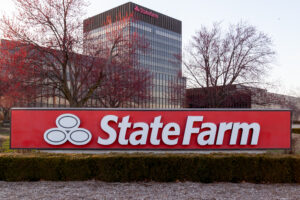Lawyers for State Farm General, the California Department of Insurance and Consumer Watchdog presented opening arguments in a hearing to determine the fate of State Farm’s request for an emergency homeowners rate increase yesterday.
The public hearing in Oakland, Calif., before Administrative Law Judge Karl-Fredric Seligman was originally set for parties to present arguments for and against a 22% rate hike. But last Friday, State Farm’s California homeowners insurer and CDI agreed that the figure for the interim increase could be lowered to 17%.
Importantly, that agreement not only brought the rate request down 5 percentage points but also stipulated that State Farm Mutual—the parent company—would make a $400 million capital infusion into State Farm General (via a surplus note) and that if a full hearing, scheduled for June, finds the 17% is not actuarially supported, then the company will repay policyholders with interest.
In late February, when executives from State Farm General and representatives of Consumer Watchdog informally met with California Insurance Commissioner Ricardo Lara, Lara pressed to get some assurance that State Farm Mutual would step in to shore up the financial condition of its California subsidiary, which executives presented as a dire one—falling close to regulatory action levels and prompting negative actions from rating agencies. He also asked State Farm General to consider pausing previously planned policy nonrenewals, a concession that an executive said wasn’t likely at the time although he did agree that making a commitment not to nonrenew any more customers was a possibility.
Related: S&P Puts State Farm General Ratings on CreditWatch; State Farm Stronger as Underwriting Losses Shrink—But Not in California
That last commitment is set forth in the agreement documented by CDI and State Farm General late last week. “Additionally, the Parties stipulate and agree that Applicant [State Farm General] shall not initiate any new block nonrenewal program(s) in the lines represented by the Applications through year-end 2025,” the April 4 amended stipulation document says.
On March 14, Lara had provisionally approved State Farm’s request for an emergency 22% interim rate increase, only if the company could justify it with data in the public hearing scheduled to start yesterday. At the time, he called on State Farm to halt nonrenewals and pursue a $500 million capital infusion from its parent company to restore financial stability.
The first several hours of yesterday’s ALJ hearing, open to the public and available to view via livestream, were devoted to procedural matters including whether the 17% amended stipulation was filed on time, whether an actuary who does work for CDI could testify on behalf of State Farm General, and whether the discussion of State Farm General’s financial condition or it’s risk-based capital level should even be presented at a rate hearing.
“Rates must reflect actual risk and costs—not an effort to restore profits or maintain credit ratings,” Consumer Watchdog said in a statement, echoing arguments made by the consumer group’s attorneys William Pletcher and Ryan Mellino at the hearing. Consumer Watchdog is serving as the intervenor in accordance with provisions of Proposition 103.
During opening arguments, Katherine Wellington of the law firm Hogan Lovells U.S., representing State Farm General, noted that the January 2025 wildfires had made State Farm General’s financial condition even worse than it was when the company originally filed for rate increases last year, with surplus now down to $600 million versus $4 billion just a decade ago in 2015.
Related: State Farm Has Paid Out $2.5 Billion for LA Wildfires
Nikki McKennedy, assistant chief counsel in CDI’s Rate Enforcement Bureau, argued that the commissioner has every right to consider the insurer’s solvency. “Consumer Watchdog contends the commissioner does not have authority to do anything but rigidly apply his own ratemaking formula and that the commissioner must deny State Farm’s request for emergency relief because they have not demonstrated the company is entitled to a rate increase under the formula,” she said, offering reasons why this idea is “without merit.”
She said the commissioner’s ratemaking formula “contains an express exception where a company’s solvency is at stake” and that the California Supreme Court previously recognized the commissioner’s “plenary authority to take whatever steps are necessary to implement Prop 103.”
“Approving State Farm General’s emergency request for an interim rate increase is a very necessary step. It is not in California consumers’ best interests to allow State Farm General, the largest property insurer in California by far…to go bankrupt or to otherwise withdraw from the California market,” she said.
“Nothing in this situation is normal. The normal rules don’t apply. We’re on the Titanic and we see the iceberg. Now is not the time to argue about where to put the deck chairs.” Asserting that it’s time instead to “turn this ship around,” McKennedy said, “If we don’t, [then] over 3 million Californians are going in the water and there are not enough life boats.”
Wellington argued that the interim rate “poses no risk to policyholders because if the final rate ends up being lower than the interim rate, policyholders will be entitled to a refund of the difference with interest.”
 That didn’t sit well with Consumer Watchdog’s Pletcher. “A collect-now-maybe-pay-later scheme is the exact opposite of prior rate approval required by California voters” under Proposition 103. “[Refunds] are not a permission slip to charge unlawful rates today to maybe correct them later. And they don’t insulate the company or the department for the legal requirements to set rates prospectively based on a full evidentiary hearing…”
That didn’t sit well with Consumer Watchdog’s Pletcher. “A collect-now-maybe-pay-later scheme is the exact opposite of prior rate approval required by California voters” under Proposition 103. “[Refunds] are not a permission slip to charge unlawful rates today to maybe correct them later. And they don’t insulate the company or the department for the legal requirements to set rates prospectively based on a full evidentiary hearing…”
“Refunds also don’t fix damage done now,” he said, referring to the damage to a homeowner that is forced to pay what the consumer group calculates to be $470 in added premiums, on average. That homeowner is forced to choose between paying a new premium or paying their mortgage.
Refunds, he said, “don’t help a family that gets nonrenewed or priced out and can’t find replacement coverage. These harms are immediate and in many cases they can be irreversible. Every dollar charged under an unjustified rate is a dollar wrongfully taken. It’s taken from a family trying to keep their home to put food on the table,” he said.
He also introduced arguments that State Farm General’s problem are problems of its own making—created by keeping rates low in order to grow market share and overpaying for reinsurance from parent company State Farm Mutual with no significant recovery for policyholders until this year. (State Farm has said that reinsurance recoveries will cut $7.6 billion in direct wildfire losses down to $212 million on a net basis.)
California’s ratemaking formula is “designed to match price to risk. It’s not designed to solve business problems, to manage market volatility or restore capital,” Pletcher said, arguing that State Farm cannot rely on its financial condition to justify a rate increase in the state under current laws.
Only one witness testified at the hearing after opening arguments—David Appel, who is retired from a former position as Principal and Director of Economics Consulting at Milliman, currently doing consulting work for State Farm General. On direct examination, Michael Maddigan of Hogan Lovells asked Appel to justify a statement in his declaration not unlike the argument that Wellington put forth—that there’s no risk to policyholders in granting the 17% rate increase with the condition of potential refunds following a full Prop 103 hearing.
Said Appel, “I don’t deny that policyholders will pay a higher premium in the near term, [but] that higher premium in my view is warranted because the exposure and risk in California is so evidently significant.”
“I appreciate the needs of consumers and the burdens that this may place on [them]. I’m mindful of that. But I’m also mindful of the financial condition of the largest insurer in the state, and the fact that insurance rates have to be adequate to cover underlying insurance costs. That has not been the case for State Farm General…for the last decade.
Appel added that he did not mean to suggest that an insurance company’s financial condition “is something that you put into a rate template and determine a rate change based upon. But it’s something the commissioner has to consider because the commissioner’s primary responsibility, in my view, is ensuring the financial solvency of the insurers under [his] authority.”
The economist said he believes that taking State Farm General’s “stressed financial condition” into account “is entirely appropriate in the case of an interim rate increase that has a dramatic level of protection for policyholders.”
“Absent the rate increase and absent the capital infusion, I think it’s like rolling the dice. You don’t know what is going to happen to State Farm General,” he said.
“If you want to take the risk that State Farm General is going to remain viable and remain in the market, I think that’s a big risk to take…The other side of that is to grant the interim rate increase, get the $400 million surplus note, restore to some extent the financial condition of the company, and then go to a rate hearing and determine whether it’s reasonable,” he said, concluding his opinion on the question.
The hearing resumes at 10 a.m. Pacific time on Wednesday, with cross-examination of Appel by Consumer Watchdog on the agenda.
Once the hearing concludes, the judge will provide the commissioner with a proposed decision for acceptance of the interim rate increase in accordance with Insurance Code (section 1861.08), according to the language of Lara’s March 14 order for the hearing provisionally granting an interim increase. The proposed decision is to be delivered within 10 days.
Topics California
Was this article valuable?
Here are more articles you may enjoy.



 3 Emerging Risks to Watch: 6G Wireless Technology, Autonomous Trucks, Kratom
3 Emerging Risks to Watch: 6G Wireless Technology, Autonomous Trucks, Kratom  Group Sues California Department of Insurance Over FAIR Plan Surcharges
Group Sues California Department of Insurance Over FAIR Plan Surcharges  State Farm Wins Dismissal of Class Action Over Xactimate Software
State Farm Wins Dismissal of Class Action Over Xactimate Software  Tesla Slumps Below 50% Share of California’s Electric Car Market
Tesla Slumps Below 50% Share of California’s Electric Car Market 


